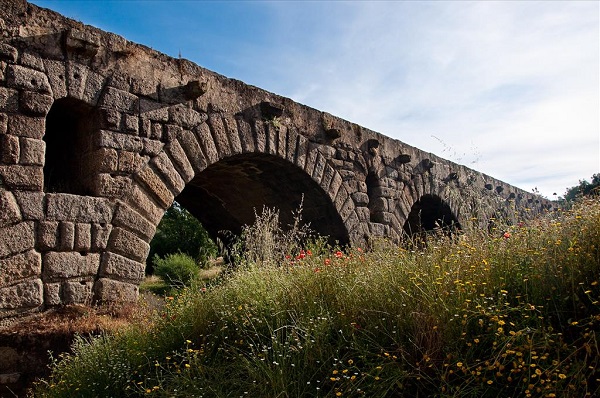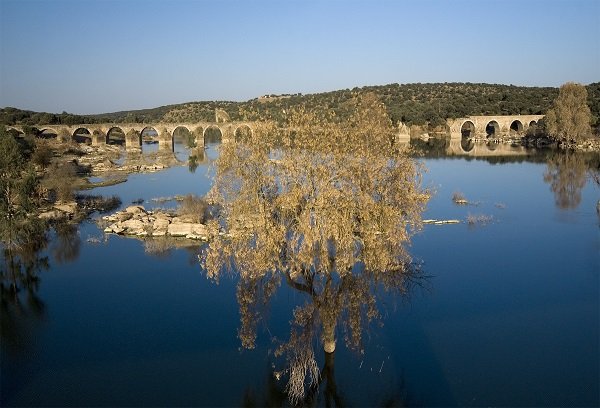The ancient Romans ruled most of what would become Portugal from the 3rd century BCE to the 4th century ACE. They left behind their language, cities, and a network of roads. And on those Roman roads were bridges. The Romans perfected the stone bridge with uniform arches and keystones and their own unique concrete. In the highly Romanized Alentejo many of these ancient structures not only survive, but thousands of years after being built, they are still being used. And, these ancient spans represent a wonderful connection to the hundreds of Roman bridges that survived antiquity. A directory of Roman bridges shows that more than 330 Roman stone bridges still carry traffic today in Europe. Known for lasting, most Roman bridges had semicircular arches, and were built with volcanic ash, lime and gypsum.
Bridges were constructed by Rome to serve the needs of the military and the empire's economy. Long after the Empire fell, Roman bridge-building techniques were copied in Portugal and around Europe. In fact, some bridges that are called "Roman” are much later — but used the design of the Romans. In fact, when Portugal launched its age of exploration, the concept of the Roman bridge spread to Asia, America and Africa.
Roman engineers would begin construction with a stone foundation in watertight walls. Often entire rivers were diverted to allow for better construction. Their concrete has been recently shown to be superior to what we use today.
To the Romans, the Alentejo was a source of wheat, the fundamental grain of the Empire. Bread was free to citizens, so wheat was very important. Alentejo wheat was the backbone of the Romanization of the region called Lusitania. To get it to the cities, you needed a good system of roads and bridges. It was important that Julius Caesar gave his name to the city of "Ebora Liberalitas Julia” or Evora, the Liberty of Julius (Caesar).
At Mértola (Roman Myrtilis), a vital port up the Guadiana River, a rare set of piers from a bridge once offered access to a tower that controlled river access into the city. This access road, built on a solid series of arches, connected the tower to the city and its merchants. The remains still stand today under the walls of Mértola.
In Mirobriga Celticorum, a lost Roman town set near the coast, we find a single-arch bridge that offers crossing along the west-east road leading to the now partially excavated town. The bridge is built of limestone, and the Roman paving stones survive.
The Ponte de Vila Ruiva over the River Odivelas outside of Cuba connected Ossonoba (today’s Faro) to Pax Iulia (Now called Beja) and on to Ebora (Évora). The original bridge, made of local granite, is early — from the 1st century BCE, with repairs being made in the 5th and 11th centuries. Those were solid repairs, as the bridge is still in use.
The Bridge of Vila Formosa Ponte de Seda crosses the Seda River and is in remarkable shape. It was built in the 1st century ACE and connected the regional capital of Merida to Olissippo (Lisbon). It is still being used. There is a small car park and picnic area on your right about 100 meters before the bridge. The bridge was constructed with portico-shaped eyehole arches between the arches to protect the structure during floods, a common design in Roman bridges.


Bridge over Ribeira Grande de Monforte-This Roman bridge located on a road that connected Lisbon to Mérida is a typical five arched bridge with trestle deck. It is believed to date to the time of the Emperor Hadrian, and is still intact and very much used today.
The Alvalade Roman Bridge near Santiago do Cacem linked the cities of Miróbriga and Pax Iulia (Beja) through Vipasca (Aljustrel). It underwent restoration work in 2001 and can be crossed on foot.
Another Roman bridge was submerged by the waters of the Pego do Altar dam for 2 decades. The still intact bridge near Alcácer do Sal is sometimes visible when water levels drop, and the ancient bridge returns like Brigadoon.
Nossa Senhora da Enxara Bridge, over the Xévora River near the abandoned fortier town of Ouguela near Campo Maior, is a bridge of uncertain history, quite ruined, with only one perfect arch intact. It was on the Roman Road from the provincial capital, Emerita Augusta (Mérida), to Olisipo (Lisbon). Great area for hikes.
The Ponte Antiga do Xarrama is located not far from Évora at the Herdade da Chaminé, and the span crosses the Xarrama River. A ruined bridge, of which three round arches and a rectangular cross-section outlet remain, it used granite as a raw material, with fine stonework on the staves and walls. It has a horizontal deck with gutters to drain rainwater.
Tradition has it that Portagem Bridge, over the Sever River, was one of the toll gates established by King Joao II (1455-1495) to tax Jews fleeing from Spain. But it began as a Roman Road. Around the bridge, there is also a set of legends that associate its construction to a pact with the devil, a narrative oddly common to ancient bridges of the Iberian Peninsula, especially those of Roman origin.
Just north of the village of Fronteira, on the road to Alter do Chão, stands an ancient bridge with ten semicircular arches, made of granite. The Ribeira Grande Bridge is thought to be Roman not only because of the type of construction but because of the fact of the Roman road it crosses. The entire surrounding area is a river beach today with nice picnic spots.
Cabeço de Vide is set on the southern slope of a hill, extending to a plain that is considered the widest between the Tejo and the Guadiana. The Romans thrived here for several centuries, and the main road from Lisbon to Mérida passed here too. The Sulfúrea hot springs were a popular spa in Roman times, and today a tiny ruined bridge still stands on the grounds of the current spa.



